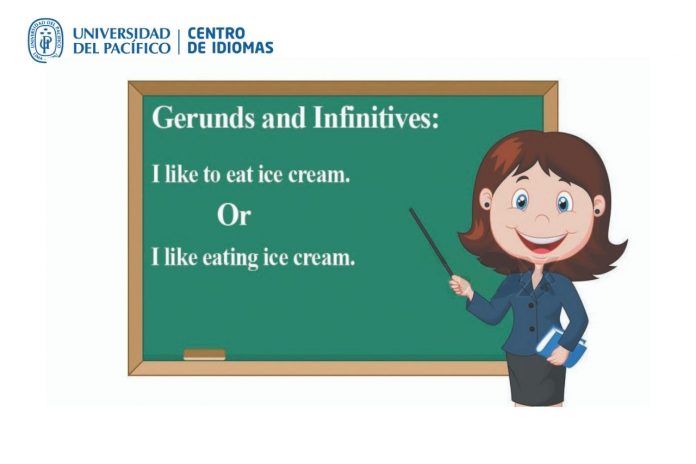What English teacher hasn’t had problems presenting the combination of one verb following another, particularly to speakers of Spanish? You have to tell your students that some verbs are necessarily followed by an infinitive while others are ineludibly tailed by a gerund. The trouble is if you have analytical learners within your pupils who ask what the criterion is to decide which verbs take one or the other, you have to confess that you have no idea. In fact, nobody in the world seems to know that. There is a list and you just have to learn it and use it. Not an answer full of logic.
But the conumdrum doesn’t end there. It turns out that certain magnanimous verbs allow you to take your pick of infinitive or gerund without changing their meaning, while others, quite more sternly, provide different meanings when followed by an infinitive or a gerund.
And to make matters even worse, some verbs are followed by infinitive with to, some others without to, some others by a gerund but with an object pronoun in between the verb and the gerund, then the gerund becomes infinitive (required writing / require her to write)
Not in vain our colleague blogger from Spain, Cristina Cabal has said about it: “I always claim that English grammar is easy, especially when compared to the Spanish or French grammar, but it gets a bit messy when it comes to verbs followed by infinitive or gerund.” (Cabal).
The use of the gerund has some basic differences in English and Spanish. In cases in which in English you can use an infinitive or a gerund interchangeably, in Spanish only an infinitive is possible. In the language of Shakespeare both, the infinitive and the subject take the function of a noun although they retain their verb meaning and so, they can be subjects of sentences (Exercising / To exerciseis healthy) or direct objects (My mother wanted me to call her / I enjoy driving). In the language of Cervantes only the infinitives (or subjunctives) are appropriate for that purpose. And that is the reason why your students tend to overuse the infinitives in English.
Then the only solution appears to be giving your pupils the wearisome lists of verbs followed by infinitives / gerunds, etc. to be memorized by them on their own, that it constitutes for them a huge, lifeless and humdrum job. But we figure that is the textbooks’ fault that this is a topic that teachers have to deal as one whole big chunk. As a rule of thumb, the natural way is usually the best way. And the manner in which native speakers learn this is not memorizing lists, but as collocations. They listen to it, they learn it and then they use it. For this purpose they don’t even have to know what a gerund or infinitive is.
 We think that if we don’t focus on teaching the grammatical process but just in associating the use of certain verbs with gerunds or infinitives, we don’t have to wait until the intermediate level. They can start as basics with verbs such as like, enjoy, adore, hate, can’t stand to learn activities, sports, foods and others, and work their way up with more complex verbs maybe to express opinions, for instance. The important thing would be to make the collocations memorable and you achieve this through extensive practice of these structures. For that you can use fill the blank exercises, complete the second sentence so that it has a similar meaning as the first, etc. Although we prefer oral practice, like, for example you ask the first student: “What do you like doing in the evenings?” He/she answers and then asks the next student: “What do you like doing on weekends?” and so on.
We think that if we don’t focus on teaching the grammatical process but just in associating the use of certain verbs with gerunds or infinitives, we don’t have to wait until the intermediate level. They can start as basics with verbs such as like, enjoy, adore, hate, can’t stand to learn activities, sports, foods and others, and work their way up with more complex verbs maybe to express opinions, for instance. The important thing would be to make the collocations memorable and you achieve this through extensive practice of these structures. For that you can use fill the blank exercises, complete the second sentence so that it has a similar meaning as the first, etc. Although we prefer oral practice, like, for example you ask the first student: “What do you like doing in the evenings?” He/she answers and then asks the next student: “What do you like doing on weekends?” and so on.Some may think that this is drilling and dream negative reminiscences of audio-lingual practices, but put your mind at rest! Not all drilling has to be bad, especially if students are communicating what they really do or like, etc. Remember that two factors spur the memory: interest and repetition. Just try to do the reiteration as enjoyable as possible. For this very purpose you can use stories, bingo, dominoes, hobbies cards, multiple answers with flashcards and other resources that have been specially designed to teach this and you can find in the internet free of charge
REFERENCES
Cabal C. Grammar for Intermediate Level: Gerunds and Infinitives
Cabal, C. Some Activities to Teach Gerunds and Infinitives. C. Blog de Cristina
Gerunds and Infinitives
Gerund and infinitive Dominoes. TEACHTHIS. EFL/ESL Resources https://es.scribd.com/document/340843349/Gerund-and-Infinitive-Dominoes
Gerund and infinitive Master. TEACHTHIS. EFL/ESL Resources
Gerunds and Infinitives Worksheet
How to Teach Gerunds and Infinitives to ESL Students Without Confusing Them. FluentU English Educator Blog.
Infinitives and Gerunds. Grammar and Beyond Communicative Activities © Cambridge University Press 2012 http://www.cambridge.org/grammarandbeyond/wp-
Joyce B. I Like Swimming. 3 Tremendous Techniques for Teaching Gerunds and Infinitiveshttp://busyteacher.org/10729-teaching-gerunds-infinitives-3-tremendous.html
Some Activities to Teach Gerunds and Infinitives
Song Worksheet: Gerunds or Infinitives?
Trusler, T. Gerunds and Infinitives: Helpful Teaching Tips http://blog.esllibrary.com/2013/02/21/gerunds-and-infinitives-helpful-teaching-tips/
Use of gerunds in Spanish
.
Estimated reading time: 4 minutes, 39 seconds










